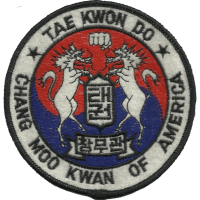The Credo of Chang Moo Kwan
Tae Kwon Do Chang Moo Kwan

Headquarters:
Seoul, Korea
Founders:
Byung-In Yoon & Nam-Suk Lee
Current President:
Kim Soo Bae
The History of Chang Moo Kwan
Korea was liberated after World War II in 1945, and the history of Chang Moo Kwan began with its liberation. Korean Masters who had left Korea when Japan occupied came back to Korea at the end of the second World War to renovate the spirits and techniques of Tae Kwon Do in liberated Korea. Grand-Master Byung-In Yoon, who’s Tae Kwon Do had a King Fu influence from when he studied in China as a child, was among these masters who returned to Korea, and lost no time in establishing a Tae Kwon Do club at Kyung-sung Agricultural High School in Seoul, Korea. On September 1, 1946, Grand-Master Yoon founded the “YMCA Kwon Bop Boo” in Seoul and was inaugurated as its first instructor.
Grand-Master Yoon’s style of Tae Kwon Do was expanded as another club in the Ministry of Communications of the Republic of Korea in March of 1947. It was established in many branches of high schools and colleges until the Korean War broke out in June of 1950. Many of his instructors and black belts were scattered throughout the peninsula and fought against the communists during the war. Upon returning from the refugee camps and recovering the capital city in 1953, training resumed and the headquarters were reopened. Unfortunately, Grand- Master Yoon went missing during the war, and the vacant presidency was filled by Nam-Suk Lee, his top student, who changed the name to Chang Moo Kwan.
Chang Moo Kwan has promoted Tae Kwon Do both nationally and internationally. According to the census of 1976, which was Chang Moo Kwan’s 30th anniversary, there were 700 Tae Kwon Do studios and clubs in Korea, with hundreds of instructors teaching this art under the Chang Moo Kwan flag at 400 studios and clubs around the world.
